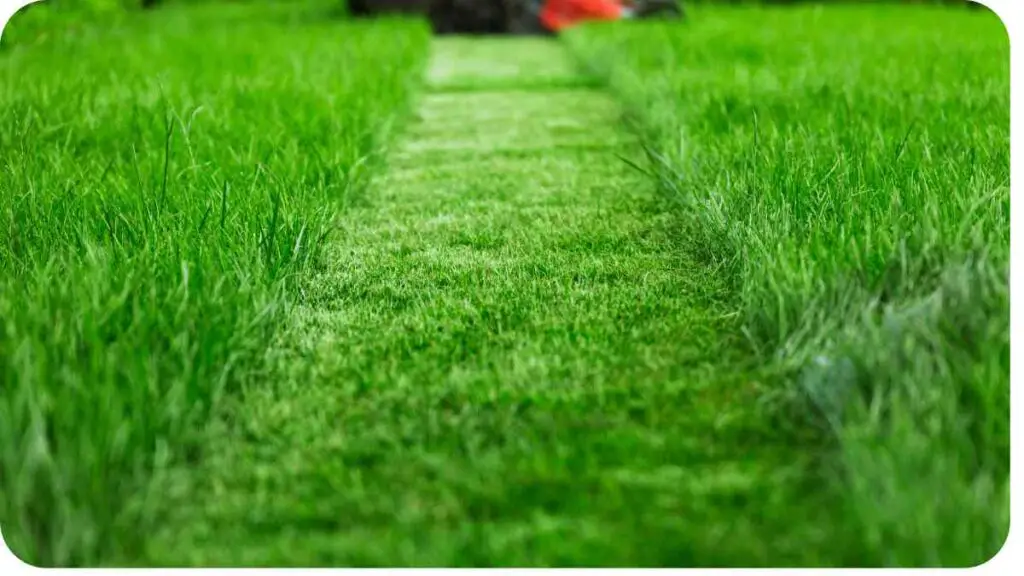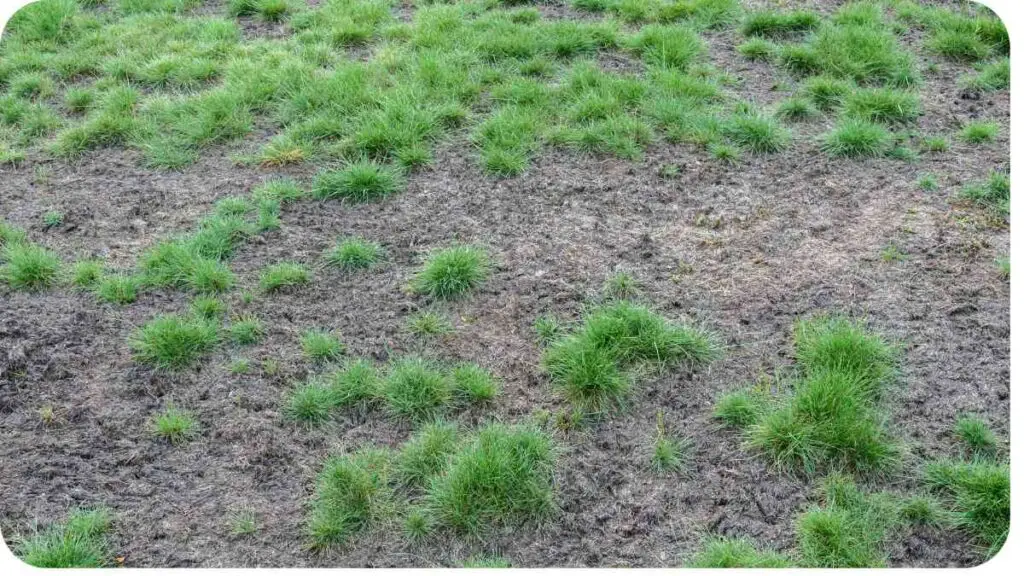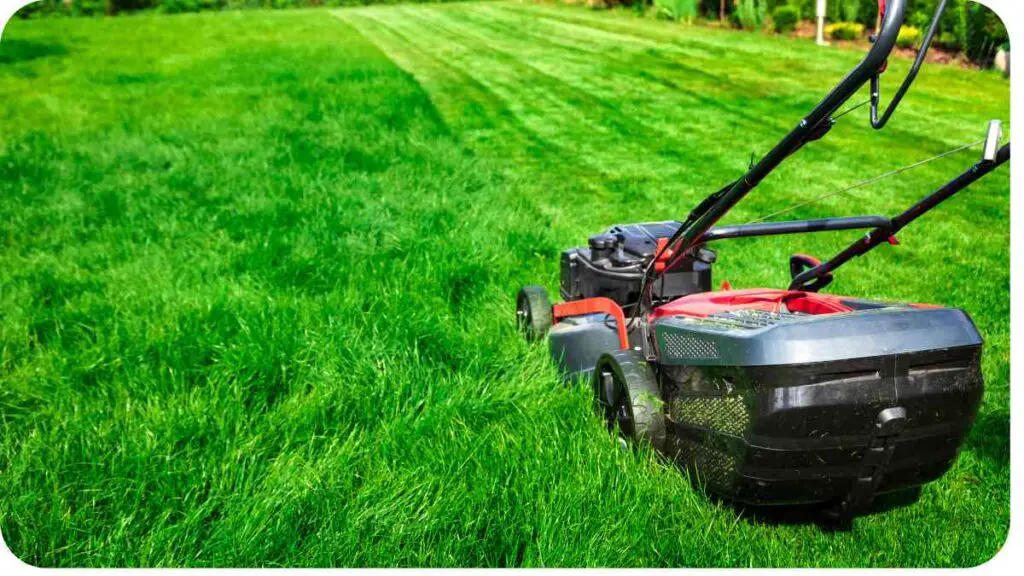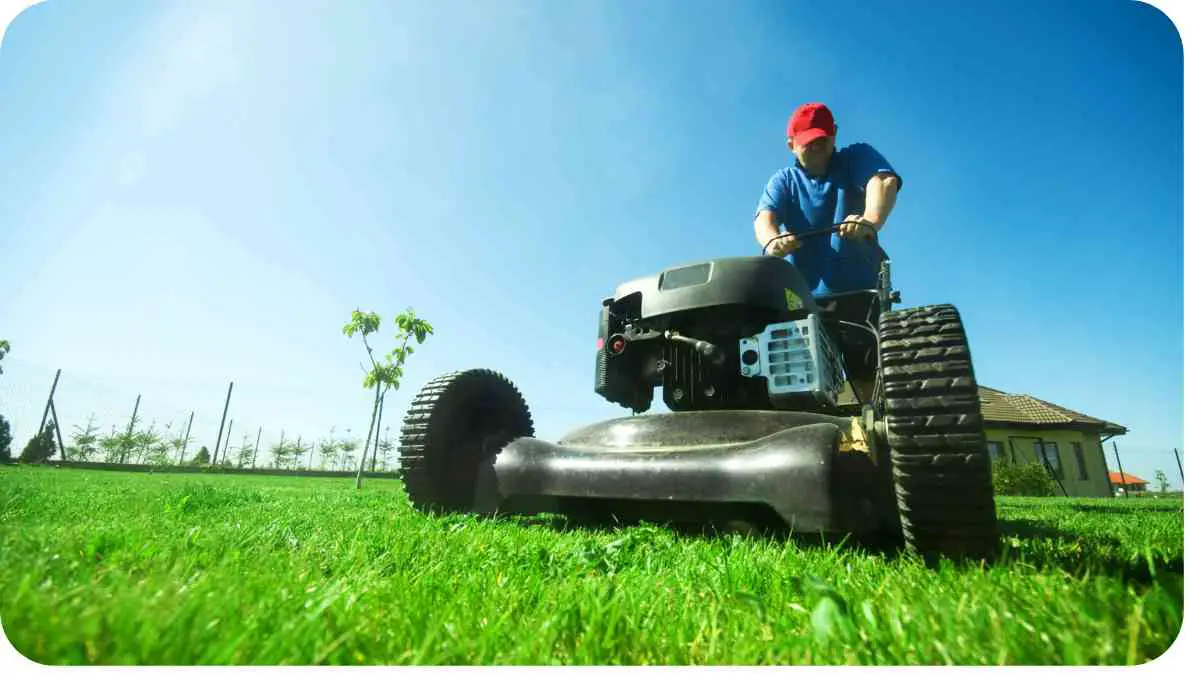Mowing the lawn is a common household chore, but it’s not without its risks. In this article, we’ll delve into the potential health hazards associated with lawn mowing and provide practical tips to help you stay safe and prevent illness.
From understanding common lawn diseases to implementing effective preventative measures, we’ve got you covered. Let’s ensure your yard work doesn’t compromise your well-being.
For those looking for lawn mower maintenance tips, our post on Can You Go Backwards with a Lawn Mower? Owner Experience offers valuable insights from lawn mower owners. Join us on our gardening journey and discover more ways to stay healthy and safe while maintaining your outdoor space.
| Takeaways |
|---|
| Mowing the lawn can lead to health issues such as sinus infections, allergies, and respiratory problems. |
| Grass allergies are a common issue that can be prevented by wearing protective gear and taking allergy medication. |
| Symptoms of a sinus infection caused by mowing the lawn include facial pain, a stuffy or runny nose, headache, and fever. |
| To prevent getting sick after mowing the lawn, take breaks, stay hydrated, wear protective gear, and avoid mowing in extreme heat or humidity. |
| If you feel sick after mowing the lawn, rest and drink plenty of fluids. Seek medical attention if symptoms persist or worsen. |
Can You Get Sick from Mowing the Lawn?

Yes, indeed, mowing the lawn can pose health risks. Among the primary concerns are fungal and bacterial diseases, with fungal infections being more prevalent than bacterial ones. These diseases can potentially affect individuals who engage in lawn care activities without adequate precautions.
Preventing Illness from Lawn Mowing
Protecting yourself from potential illness while mowing the lawn is crucial. Here are some effective preventive measures:
- Wear Proper Protective Gear: Equip yourself with a mask, long pants, sleeves, and gloves to shield your skin and respiratory system from allergens and pathogens present in grass and soil.
- Practice Good Hygiene: After mowing, thoroughly wash your hands to remove any dirt, allergens, or pathogens that may have come into contact with your skin.
- Avoid Mowing in Wet Conditions: Mowing wet grass can create muddy conditions that facilitate the spread of diseases. Wait until the lawn is dry before proceeding with mowing.
- Assess Your Health Status: If you’re feeling unwell or suspect that your immune system may be compromised, consider postponing lawn mowing until you’re in better health. Prioritize your well-being to avoid exacerbating any existing health conditions.
By implementing these precautions, you can significantly reduce the risk of falling ill while tending to your lawn. Stay safe and enjoy your outdoor activities!
“Dealing with crabgrass can be a hassle, but there are natural methods you can use to get rid of it without harming your lawn. Our article on killing crabgrass without killing your lawn explores some effective techniques that are safe for your lawn and the environment.”
Common Lawn Diseases and Treatment Methods
- Fungal Diseases: Fungal infections in lawns are primarily caused by fungi and can spread through various means such as insects or wind. Symptoms include yellow or brown patches of grass with blackened blade tips. Treatment typically involves preventive measures like applying fungicides to the soil. In severe cases, it may be necessary to remove affected areas to eliminate remaining roots.
- Insects and Associated Diseases: Insects like ticks can harbor disease-causing agents that are transmitted to other organisms during feeding. While not directly related to lawn diseases, insect-borne illnesses can pose risks to human and pet health. Controlling insect populations through appropriate pest management measures can help reduce disease transmission.
- Bacterial Diseases: Bacterial infections in lawns are less common but can still occur. Bacteria, being smaller organisms lacking internal organs like humans, can cause diseases in plants. Symptoms may include discoloration, wilting, or lesions on grass blades. Treatment typically involves cultural practices such as improving drainage and avoiding overwatering to prevent bacterial proliferation.
Identifying Signs of Lawn Disease

Regular lawn maintenance is essential for a well-kept yard, but it’s also crucial to be vigilant for signs of disease. Here are some common symptoms indicating diseased grass:
- Discoloration: Yellowing or browning of the lawn may indicate parasitic infections like dollar spot. Dollar spot manifests as small circular patches resembling coins. Additionally, an abundance of weeds can compete with grass for nutrients, leading to discoloration as the weeds die off and decompose.
- Patchy Growth: Uneven or patchy growth across the lawn can be a sign of underlying disease or nutrient deficiencies. Pay attention to areas with stunted or sparse grass growth, as they may require targeted treatment.
- Thinning or Wilting: Grass blades that appear thin, wilted, or have a lackluster appearance may be indicative of disease or stress. Check for signs of root damage or soil compaction, which can contribute to grass decline.
- Presence of Fungal Growth: Visible fungal growth on grass blades or soil surface, such as mold or mildew, suggests fungal infection. Fungi thrive in moist environments, so monitor areas with poor drainage or excessive moisture accumulation.
- Unusual Texture or Smell: Abnormal textures or foul odors emanating from the lawn may signify bacterial or fungal infections. Pay attention to any changes in the lawn’s appearance or smell during routine maintenance.
“Maintaining a lush, green lawn doesn’t have to involve the use of harmful chemicals. Our article on having a nice lawn without chemicals explores natural methods for keeping your lawn healthy and beautiful, without risking your health or the environment.”
Optimal Treatment for a Diseased Lawn
Addressing lawn diseases requires a multifaceted approach to restore health and vitality to the turf. Here’s an effective treatment plan:
- Apply Balanced Fertilizer: Incorporate a balanced fertilizer with a high nitrogen content to promote overall lawn health. Nitrogen supports lush, green growth and aids in recovery from disease stress. Additionally, ensure the fertilizer mix includes adequate phosphorus for robust root development and potassium for improved disease resistance.
- Correct Nutrient Imbalances: Conduct a soil test to identify any nutrient deficiencies or imbalances in the lawn. Address deficiencies by supplementing with specific micronutrients like magnesium, which is crucial for chlorophyll production and preventing yellowing of leaves.
- Improve Soil Drainage: Enhance soil drainage to prevent waterlogging, which creates favorable conditions for fungal growth. Incorporate organic matter into the soil, such as compost or well-rotted manure, to improve soil structure and drainage capabilities.
- Implement Cultural Practices: Adopt cultural practices that promote lawn resilience and discourage disease development. This includes proper mowing techniques to maintain optimal grass height, adequate watering practices to prevent drought stress or overwatering, and regular aeration to alleviate soil compaction and improve nutrient uptake.
- Address Fungal Infections: Treat fungal infections with fungicides specifically formulated for lawn diseases. Follow application instructions carefully and reapply as needed to effectively control fungal growth and prevent further spread.
- Monitor and Prevent Future Outbreaks: Regularly monitor the lawn for signs of disease recurrence and implement preventive measures to minimize future outbreaks. This may include adjusting watering schedules, promoting good airflow and sunlight penetration, and practicing proper lawn maintenance techniques.
Understanding Lawn Browning
If you’ve observed brown spots on your lawn, several factors may contribute to this issue:
- Rust Fungus: Rust fungus, prevalent during summer months, infects grass blades, causing them to turn brown. This fungal infection commonly affects perennial ryegrass but can also impact other warm-season grasses.
- Chafer Grub Infestation: Brown patches may indicate an infestation of chafer grubs, the larvae of green June beetles or Japanese beetles. These grubs feed on grass roots, leading to damage and browning of the turf. Infestations typically occur between June and August.
- Environmental Stress: Environmental factors such as drought, heat stress, or excessive foot traffic can contribute to lawn browning. Insufficient watering or poor soil conditions may exacerbate stress and result in brown patches.
- Soil Compaction: Compacted soil restricts root growth and water absorption, leading to browning of the lawn. Compaction often occurs in high-traffic areas or where heavy equipment has been used.
- Nutrient Deficiencies: Inadequate nutrients, particularly nitrogen, phosphorus, or potassium, can cause grass to turn brown. Conduct a soil test to assess nutrient levels and address deficiencies through proper fertilization.
- Disease or Pest Infestations: Various diseases and pests, aside from rust fungus and chafer grubs, can contribute to lawn browning. These include fungal infections like dollar spot or brown patch disease, as well as pests such as grubs, armyworms, or chinch bugs.
Causes of Brown Spots on Grass in Winter
Brown spots on grass during winter may result from various factors, including:
- Overwatering: Excessive irrigation can lead to waterlogged soil, causing root suffocation and subsequent brown spots. Overwatering fosters conditions conducive to root rot, where soil bacteria and fungus thrive, accelerating root decay. Avoid over-irrigation to prevent waterlogging and associated issues.
- Nutrient Deficiency: Inadequate nutrient levels in the soil can manifest as brown or yellow patches on grass, particularly during winter when growth slows. Lack of essential nutrients like nitrogen, phosphorus, or potassium can impair grass health and color. Regularly fertilize your lawn to ensure optimal nutrient levels and prevent deficiencies.
- Poor Soil Drainage: Compacted or poorly draining soil hampers water infiltration and root development, leading to brown spots. Address soil compaction through aeration and improve drainage with proper grading or installation of drainage systems to mitigate waterlogged conditions.
- Disease Susceptibility: Weak or stressed grass is more vulnerable to disease outbreaks, resulting in brown spots. Fungal pathogens may thrive in moist, cool winter conditions, causing diseases like snow mold or fusarium blight. Implement preventive measures such as proper lawn maintenance and disease-resistant grass varieties to minimize disease risks.
- Pest Activity: Pest infestations, such as grubs or rodents, can damage grass roots, leading to brown spots in winter. Monitor for signs of pest activity and employ appropriate control measures if infestations are detected.
- Environmental Factors: Extreme weather conditions, including freezing temperatures, frost, or snow cover, can stress grass and cause brown spots. Minimize traffic on frozen or snow-covered turf to prevent damage, and avoid applying de-icing salts that can harm grass.
“Carbon monoxide poisoning is a serious health hazard that can occur when using a lawn mower. Our article on carbon monoxide poisoning from a lawn mower provides information on the dangers of carbon monoxide and how to prevent exposure while mowing the lawn.”
Can Mowing the Lawn Make You Sick?

Yes, mowing the lawn can potentially lead to illness if proper precautions aren’t taken. While susceptibility varies among individuals, prolonged exposure to yard work can increase the risk of health issues.
To minimize the likelihood of getting sick from mowing the lawn, consider the following precautions:
- Maintain a Clean Yard: Remove debris, weeds, and leaf litter from your yard regularly. Accumulated organic matter can harbor pests and disease-causing organisms, increasing the risk of illness.
- Use Protective Gear: Wear appropriate protective equipment, including eyewear and gloves, to shield yourself from potential hazards such as sharp objects, chemicals, and allergens like grass pollen. Protective gear helps mitigate the risk of injuries and allergic reactions.
- Stay Hygienic: Practice good hygiene habits, such as washing your hands thoroughly after mowing, to reduce the likelihood of transferring contaminants to your mouth, nose, or eyes.
Mowing When It’s Wet: Safety Considerations
Mowing the lawn when it’s wet poses significant safety risks, primarily due to the potential for electrocution. Here’s why it’s crucial to avoid using a wet mower:
- Electrocution Hazard: Wet conditions increase the likelihood of electrical hazards when operating electric mowers or using electrical extension cords. Water can conduct electricity, creating a pathway for electrical currents to flow through the mower, cords, and ultimately, the operator’s body. This poses a severe risk of electrocution and can be fatal.
- Equipment Damage: Wet grass and soil can also damage the mower’s electrical components, leading to equipment malfunction or failure. Moisture infiltration may cause short circuits, corrosion, or damage to the mower’s motor and wiring, compromising its performance and safety.
- Slippery Conditions: Wet grass can create slippery surfaces, increasing the risk of slips, falls, and injuries while maneuvering the mower. Loss of traction may result in accidents, especially on slopes or uneven terrain, posing a danger to the operator and bystanders.
- Poor Mowing Results: Mowing wet grass can result in uneven cutting, clumping of grass clippings, and potential damage to the lawn. Wet grass blades are more prone to tearing rather than clean cutting, leading to an unsightly lawn appearance and potential lawn health issues.
Safety Tips for Mowing on Hot Days
Mowing the lawn on a hot day requires careful consideration of personal safety to prevent heat-related illnesses and sunburn. Here are essential tips to ensure a safe mowing experience:
- Stay Hydrated: Prioritize hydration by drinking plenty of water before, during, and after mowing. Dehydration can occur rapidly in hot weather, leading to fatigue, dizziness, and heat exhaustion. Keep a water bottle nearby and take regular breaks to rehydrate.
- Take Frequent Breaks: Limit prolonged exposure to the sun by taking frequent breaks in shaded areas. Schedule mowing sessions during the cooler parts of the day, such as early morning or late afternoon, to minimize heat exposure.
- Use Sun Protection: Protect your skin from harmful UV rays by applying sunscreen with a high SPF rating before heading outdoors. Wear lightweight, breathable clothing that covers exposed skin, including a wide-brimmed hat and sunglasses to shield your face and eyes from direct sunlight.
- Avoid Overexertion: Pace yourself and avoid overexertion while mowing, especially in extreme heat. Listen to your body’s cues and take breaks as needed to prevent heat-related illnesses such as heat stroke or heat exhaustion.
- Stay Cool: Use cooling measures such as wet towels or cooling vests to lower body temperature during mowing. Consider using a cooling neck gaiter or bandana to keep your neck cool and minimize heat stress.
- Adjust Mowing Practices: Adjust mowing frequency and duration to accommodate hot weather conditions. Raise the mower deck to leave grass blades longer, which helps retain moisture and reduces heat stress on the lawn.
Preventing Lawn Diseases in Your Yard
Maintaining a healthy lawn involves proactive measures to prevent the onset and spread of diseases. Here are some effective strategies:
- Mow Wisely: Choose the right time of day to mow, preferably early morning or late evening when it’s cooler. Avoid mowing when grass is wet to prevent the formation of moldy patches. Additionally, ensure your mower blade is sharp to make clean cuts that minimize the risk of disease entry points.
- Manage Moisture: Proper moisture management is crucial for disease prevention. After watering, ensure excess moisture is minimized to discourage the germination of disease spores. Avoid overwatering and allow the soil surface to dry between watering sessions.
- Fertilize Responsibly: Apply fertilizer judiciously and only when necessary. Excessive fertilizer can lead to imbalances in soil nutrients, promoting disease susceptibility and excessive growth. Follow recommended application rates and schedules to maintain optimal lawn health without risking disease outbreaks.
- Utilize Mulching Mowers: Mulching mowers help recycle grass clippings back into the soil, reducing surface accumulation that can harbor fungal pathogens. Mulched clippings decompose faster, enriching the soil with nutrients and minimizing the risk of disease spread via irrigation water.
- Promote Air Circulation: Ensure adequate air circulation throughout your lawn by minimizing thatch buildup and promoting healthy grass growth. Thatch can trap moisture and provide a conducive environment for disease development. Core aerate your lawn periodically to improve soil structure and enhance air and water movement.
- Practice Proper Lawn Care: Implement a comprehensive lawn care regimen that includes regular dethatching, overseeding, and soil testing. Healthy, vigorously growing turf is more resistant to disease outbreaks. Monitor your lawn closely for signs of disease or stress, and promptly address any issues to prevent further spread.
“Mowing wet grass can be a challenge, but with the right techniques, it can be done safely and effectively. Check out our article on cutting wet grass with a lawn mower for tips on how to mow your lawn when it’s wet without damaging your mower or your lawn.”
Identifying Symptoms of Lawn Disease
Recognizing symptoms of lawn disease is essential for timely intervention and effective management. Here’s what to look out for:
- Brown or Yellow Spots: Brown or yellow patches on the grass can indicate various lawn diseases, such as dollar spot, brown patch, or rust. These patches may appear irregular or circular in shape and can spread over time if left untreated.
- Thin or Sparse Grass Growth: Areas of thin or sparse grass growth may signal underlying disease issues. Affected areas may exhibit stunted or weakened grass, with patches of bare soil becoming visible as the disease progresses.
- Abnormal Growth Patterns: Lawn diseases can cause irregular growth patterns, including distorted or discolored grass blades. Look for symptoms such as twisted or curled leaves, abnormal leaf coloration, or lesions on grass blades.
- Fungal Growth or Patches: Some lawn diseases produce visible fungal growth or patches on the grass surface. Look for signs of white, gray, or pink fungal mycelium, powdery mildew, or mold-like growths on the grass blades or soil surface.
- Water-soaked or Slimy Patches: Areas of the lawn that appear water-soaked, slimy, or excessively moist may indicate disease issues such as pythium blight or slime mold. These conditions often occur in areas with poor drainage or excessive moisture.
- Dead or Decaying Grass Tissue: Dead or decaying grass tissue, including yellowing or browning of grass blades, can indicate disease infection. Pay attention to areas where grass appears wilted, necrotic, or exhibiting signs of tissue decay.
- Circular or Ring-shaped Patches: Some lawn diseases, such as fairy rings or necrotic ring spot, form characteristic circular or ring-shaped patterns in the turf. These patches may vary in size and exhibit different degrees of discoloration or necrosis.
Origins of Lawn Diseases
Lawn diseases originate from various sources, primarily through natural processes and environmental factors. Here’s an overview of where lawn diseases come from:
- Airborne Transmission: Many lawn diseases spread through airborne transmission, facilitated by wind dispersal of fungal spores or other disease-causing agents. These spores can travel over long distances, infecting healthy grass in neighboring yards or regions. Common airborne diseases include dollar spot, brown patch, and powdery mildew.
- Rain and Moisture: Rainfall and moisture play a crucial role in the spread of lawn diseases. Excessive moisture creates favorable conditions for fungal growth and disease development. Raindrops can disperse fungal spores from infected plants to healthy ones, contributing to disease spread within the lawn environment.
- Insect Vectors: Some lawn diseases are transmitted by insects acting as vectors. Insects such as aphids, grasshoppers, and leafhoppers can carry disease-causing pathogens from infected plants to healthy ones as they feed or move through the lawn. This mode of transmission contributes to the rapid spread of diseases such as viral infections and bacterial wilt.
- Soil Contamination: Soilborne pathogens and fungal spores can persist in the soil for extended periods, remaining dormant until conditions become conducive for disease development. Soil contamination through infected plant debris, contaminated soil amendments, or previous disease outbreaks can introduce pathogens into the lawn environment, leading to disease recurrence.
- Human Activity: While less common, human activities such as improper lawn care practices or the introduction of contaminated plant material can contribute to the spread of lawn diseases. Overfertilization, excessive thatch buildup, and improper watering practices can create stress conditions that predispose grass to disease. Additionally, the introduction of infected plant material or contaminated equipment can introduce pathogens into the lawn ecosystem.
- Animal Vectors: Animals, including birds, rodents, and pets, can inadvertently contribute to the spread of lawn diseases by carrying fungal spores or pathogens on their fur, feathers, or feet. While less significant compared to other transmission routes, animal-mediated disease spread can occur, particularly in areas frequented by wildlife or pets.
Maintaining Lawn Health and Preventing Diseases
Ensuring a vibrant and disease-free lawn requires proactive measures and informed practices. Here’s how you can prevent lawn diseases and maintain a healthy green space:
- Regular Mowing: Keep your grass short by mowing it regularly. Maintaining an optimal mowing height prevents the growth of weeds and minimizes stress on the grass, reducing the risk of disease development.
- Avoid Pesticides: Limit the use of pesticides on your lawn, as these chemicals can disrupt the natural balance of the ecosystem and harm beneficial organisms. Instead, opt for integrated pest management strategies and eco-friendly alternatives to control pests while minimizing environmental impact.
- Proper Watering: Ensure your lawn receives adequate water to support healthy growth. Water deeply and infrequently to encourage deep root development and drought tolerance. Avoid overwatering, as excessively moist conditions can promote fungal growth and disease outbreaks.
- Adequate Drainage: Improve soil drainage to prevent waterlogging and reduce the risk of fungal diseases such as root rot and damping-off. Address areas of poor drainage by amending the soil, installing drainage systems, or regrading the landscape to promote runoff.
- Promote Air Circulation: Enhance air circulation within the lawn by pruning overhanging branches, thinning dense foliage, and aerating compacted soil. Improved airflow reduces humidity levels and minimizes conditions conducive to fungal diseases like powdery mildew and rust.
- Proper Fertilization: Apply fertilizers judiciously to provide essential nutrients for grass growth without promoting excessive vegetative growth. Follow recommended application rates and schedules to avoid nutrient imbalances and minimize the risk of nutrient runoff into water bodies.
- Monitor and Treat Early: Regularly inspect your lawn for signs of disease, including discoloration, wilting, or abnormal growth patterns. If you detect any symptoms, take prompt action to identify the underlying cause and implement appropriate treatment measures, such as applying fungicides or adjusting cultural practices.
- Select Disease-Resistant Varieties: Choose grass varieties and cultivars known for their resistance to common lawn diseases prevalent in your region. Disease-resistant grasses are less susceptible to infection and require fewer chemical interventions for disease management.
“Maintaining your lawn mower is an essential part of ensuring safe and efficient mowing. Our article on cleaning a lawn mower carburetor without removing it provides step-by-step instructions on how to clean your carburetor, which can improve the performance and lifespan of your mower.”
Conclusion
In conclusion, while lawn diseases pose potential challenges for maintaining a vibrant yard, the risk of getting sick from mowing the lawn can be effectively mitigated through proper precautions. By maintaining well-maintained lawn equipment and adhering to basic cleanliness practices during yard work, homeowners can minimize exposure to disease-causing agents.
Additionally, adopting preventive measures such as regular mowing, proper watering, and promoting overall lawn health can further reduce the likelihood of disease outbreaks. With diligence and care, it’s possible to enjoy a lush, healthy lawn without compromising personal health.
Remember, a proactive approach to lawn care is key to preserving the beauty and longevity of your outdoor space.
Further Reading
If you found the information in this article helpful, you may be interested in learning more about related topics. Check out these resources for further reading:
Mowing the Lawn: How it Can Lead to a Sinus Infection and How to Protect Yourself: This article provides detailed information on the link between mowing the lawn and sinus infections, as well as tips for protecting yourself from this common health issue.
Grass Allergies: Symptoms, Treatment, and Prevention: If you suffer from allergies related to grass, this article is a great resource for learning more about the symptoms, treatment options, and preventative measures you can take.
Feeling Sick After Mowing? Learn How to Avoid It: This article discusses some of the reasons why you might feel sick after mowing the lawn, as well as practical tips for avoiding this issue in the future.
FAQs
What are some common health issues associated with mowing the lawn?
Mowing the lawn can lead to a variety of health issues, including sinus infections, allergies, and respiratory problems.
How can I protect myself from grass allergies when mowing the lawn?
There are several steps you can take to protect yourself from grass allergies while mowing the lawn, including wearing a mask or respirator, taking allergy medication, and avoiding mowing when grass pollen counts are high.
What are some symptoms of a sinus infection caused by mowing the lawn?
Symptoms of a sinus infection caused by mowing the lawn can include facial pain, pressure or tenderness, a stuffy or runny nose, headache, and fever.
How can I prevent getting sick after mowing the lawn?
To prevent getting sick after mowing the lawn, it’s important to take breaks, stay hydrated, wear protective gear, and avoid mowing in extreme heat or humidity.
What should I do if I feel sick after mowing the lawn?
If you feel sick after mowing the lawn, it’s important to rest and drink plenty of fluids. If your symptoms persist or worsen, seek medical attention.

For 15 years, Hellen James has worked in the gardening industry as an expert and landscape designer. During her career, she has worked for a variety of businesses that specialize in landscaping and gardening from small firms to large corporations.

